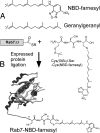Interaction analysis of prenylated Rab GTPase with Rab escort protein and GDP dissociation inhibitor explains the need for both regulators
- PMID: 17640890
- PMCID: PMC1941464
- DOI: 10.1073/pnas.0701817104
Interaction analysis of prenylated Rab GTPase with Rab escort protein and GDP dissociation inhibitor explains the need for both regulators
Abstract
Prenylated Rab GTPases regulate intracellular vesicle trafficking in eukaryotic cells by associating with specific membranes and recruiting a multitude of Rab-specific effector proteins. Prenylation, membrane delivery, and recycling of all 60 members of the Rab GTPase family are regulated by two related molecules, Rab escort protein (REP) and GDP dissociation inhibitor (GDI). Biophysical analysis of the interaction of prenylated proteins is complicated by their low solubility in aqueous solutions. Here, we used expressed protein ligation to construct a semisynthetic fluorescent analogue of prenylated Rab7, Rab7-NBD-farnesyl. This molecule is soluble in the absence of detergent but is otherwise similar in its behavior to naturally prenylated Rab7 GTPase. To obtain information on the interaction of natively mono- and diprenylated Rab7 GTPases with REP and GDI molecules, we stabilized the former molecules in solution by using the beta-subunit of Rab geranylgeranyl transferase, which we demonstrate to function as an unspecific chaperone of prenylated proteins. Using competitive titrations of mixtures of natively prenylated and fluorescent Rab, we demonstrate that monogeranylgeranylated Rab7 binds to the REP protein with a K(d) value of approximately 70 pM. The affinity of doubly prenylated Rab7 is approximately 20-fold weaker. In contrast, GDI binds both prenylated forms of Rab7 with comparable affinities (K(d) = 1-5 nM) but has extremely low affinity to unprenylated Rab molecules. The obtained data allow us to formulate a thermodynamic model for the interaction of RabGTPases with their regulators and membranes and to explain the need for both REP and GDI in Rab function.
Conflict of interest statement
The authors declare no conflict of interest.
Figures





Similar articles
-
Structure of doubly prenylated Ypt1:GDI complex and the mechanism of GDI-mediated Rab recycling.EMBO J. 2006 Jan 11;25(1):13-23. doi: 10.1038/sj.emboj.7600921. Epub 2006 Jan 5. EMBO J. 2006. PMID: 16395334 Free PMC article.
-
Membrane targeting of a Rab GTPase that fails to associate with Rab escort protein (REP) or guanine nucleotide dissociation inhibitor (GDI).J Biol Chem. 2001 Jun 8;276(23):20379-86. doi: 10.1074/jbc.M101511200. Epub 2001 Mar 16. J Biol Chem. 2001. PMID: 11389151
-
Allosteric regulation of substrate binding and product release in geranylgeranyltransferase type II.Biochemistry. 2001 Jan 9;40(1):268-74. doi: 10.1021/bi002034p. Biochemistry. 2001. PMID: 11141079
-
Molecular control of Rab activity by GEFs, GAPs and GDI.Small GTPases. 2018 Mar 4;9(1-2):5-21. doi: 10.1080/21541248.2016.1276999. Epub 2017 Feb 1. Small GTPases. 2018. PMID: 28055292 Free PMC article. Review.
-
Thematic review series: lipid posttranslational modifications. geranylgeranylation of Rab GTPases.J Lipid Res. 2006 Mar;47(3):467-75. doi: 10.1194/jlr.R500017-JLR200. Epub 2006 Jan 9. J Lipid Res. 2006. PMID: 16401880 Review.
Cited by
-
Membrane targeting mechanism of Rab GTPases elucidated by semisynthetic protein probes.Nat Chem Biol. 2010 Jul;6(7):534-40. doi: 10.1038/nchembio.386. Epub 2010 May 30. Nat Chem Biol. 2010. PMID: 20512138
-
SmgGDS: An Emerging Master Regulator of Prenylation and Trafficking by Small GTPases in the Ras and Rho Families.Front Mol Biosci. 2021 Jun 16;8:685135. doi: 10.3389/fmolb.2021.685135. eCollection 2021. Front Mol Biosci. 2021. PMID: 34222337 Free PMC article. Review.
-
Rab3D regulates amylase levels, not agonist-induced amylase release, in AR42J cells.Cell Mol Biol Lett. 2012 Jun;17(2):258-73. doi: 10.2478/s11658-012-0008-5. Epub 2012 Feb 24. Cell Mol Biol Lett. 2012. PMID: 22367855 Free PMC article.
-
The protease GtgE from Salmonella exclusively targets inactive Rab GTPases.Nat Commun. 2018 Jan 3;9(1):44. doi: 10.1038/s41467-017-02110-1. Nat Commun. 2018. PMID: 29298974 Free PMC article.
-
Rab GTPases: master regulators that establish the secretory and endocytic pathways.Mol Biol Cell. 2017 Mar 15;28(6):712-715. doi: 10.1091/mbc.E16-10-0737. Mol Biol Cell. 2017. PMID: 28292916 Free PMC article. Review.
References
-
- Gelb MH. Science. 1997;275:1750–1751. - PubMed
-
- Casey PJ, Seabra MC. J Biol Chem. 1996;271:5289–5292. - PubMed
-
- Pylypenko O, Rak A, Reents R, Niculae A, Sidorovitch V, Cioaca MD, Bessolitsyna E, Thoma NH, Waldmann H, Schlichting I, et al. Mol Cell. 2003;11:483–494. - PubMed
-
- Ghomashchi F, Zhang X, Liu L, Gelb MH. Biochemistry. 1995;34:11910–11918. - PubMed
Publication types
MeSH terms
Substances
LinkOut - more resources
Full Text Sources

